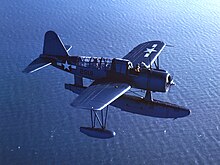
Back Vliegboot Afrikaans Hidroavión AN طائرة مائية Arabic Hidrotəyyarə Azerbaijani Гідраплан Byelorussian Хидроплан Bulgarian নৌবিমান Bengali/Bangla Dournijerez Breton Hidroavió Catalan ᎠᎹᏱ ᏗᎦᏥᎯ ᏥᏳ CHR


A seaplane is a powered fixed-wing aircraft capable of taking off and landing (alighting) on water.[1] Seaplanes are usually divided into two categories based on their technological characteristics: floatplanes and flying boats; the latter are generally far larger and can carry far more. Seaplanes that can also take off and land on airfields are in a subclass called amphibious aircraft, or amphibians. Seaplanes were sometimes called hydroplanes,[2] but currently this term applies instead to motor-powered watercraft that use the technique of hydrodynamic lift to skim the surface of water when running at speed.[1]
The use of seaplanes gradually tapered off after World War II, partially because of the investments in airports during the war but mainly because landplanes were less constrained by weather conditions that could result in sea states being too high to operate seaplanes while landplanes could continue to operate. In the 21st century, seaplanes maintain a few niche uses, such as for aerial firefighting, air transport around archipelagos, and access to undeveloped or roadless areas, some of which have numerous lakes. In British English, seaplane is sometimes used specifically to refer to a floatplane, rather than a flying boat.
© MMXXIII Rich X Search. We shall prevail. All rights reserved. Rich X Search